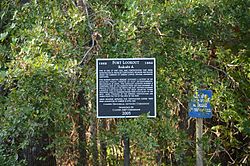
Camden is a city in and the county seat of Ouachita County in the south-central part of the U.S. state of Arkansas. The city is located about 100 miles south of Little Rock. Situated on bluffs overlooking the Ouachita River, the city developed because of the river.

Poison Springs Battleground State Park is an Arkansas state park located southeast of Bluff City. It commemorates the Battle of Poison Spring in the American Civil War, which was part of the 1864 Camden Expedition, an element of a Union Army initiative to gain control of Shreveport, Louisiana and get a foothold in Texas.
The Battle of Poison Spring, also known as the Poison Spring massacre, was fought in Ouachita County, Arkansas, on April 18, 1864, as part of the Camden Expedition, during the American Civil War. A Union force commanded by Major General Frederick Steele had moved from Little Rock, Arkansas, in support of Major General Nathaniel Banks's movement along the Red River towards Shreveport, Louisiana. Steele's objective was also Shreveport, and his men occupied Camden, Arkansas. After Banks was defeated at the battles of Mansfield and Pleasant Hill, Steele was isolated in Arkansas. Short on supplies, Steele sent a detachment commanded by Colonel James M. Williams on April 17 to forage for 5,000 bushels of corn that were reported to be in the area.
The Battle of Jenkins' Ferry, also known as the Engagement at Jenkins' Ferry, was fought on April 30, 1864, at Jenkins' Ferry, southwest of Little Rock, during the American Civil War. Although the battle ended with a Union victory, the Confederates saw it as a strategic success as they claimed to have prevented Frederick Steele from holding southwest Arkansas. Due to the chaotic nature of the battle, casualty figures vary.
The Battle of Prairie D'Ane, also known as the Skirmish at Prairie D'Ane, Battle of Gum Springs, or Battle of Moscow, was fought in present-day Nevada County, Arkansas, as part of the Camden Expedition, during the American Civil War. The Camden Expedition was launched by Union forces as part of the Red River Campaign of 1864. U.S. planners envisioned two federal armies converging simultaneously, one force under the command of Maj. Gen. Nathaniel Banks pressing northward up the Red River commencing at Alexandria, Louisiana and the other federal army under the command of Maj. Gen. Frederick Steele driving southwestward from Little Rock, Arkansas. The objective was to press the rebel army of Gen. E. Kirby Smith back upon the rebel stronghold at Shreveport and defeat him. If successful, a somewhat vague second phase envisioned the two federal armies combining into one large force and continuing their offensive with a westward push into Texas.
The Camden Expedition was the final campaign conducted by the Union Army in Arkansas during the Civil War. The offensive was designed to cooperate with Major-General Nathaniel P. Banks' movement against Shreveport.

The 27th Wisconsin Volunteer Infantry Regiment was an infantry regiment that served in the Union Army during the American Civil War. The regiment began organizing in August 1862 but recruiting problems delayed its entry into federal service until March 1863. Predominantly from the Lake Michigan shore counties of the state, the regiment was mainly composed of German immigrants. The 27th Wisconsin played a supporting role in the Siege of Vicksburg and participated in the capture of Little Rock, Arkansas during the year. The regiment served in the Little Rock garrison and saw its first serious combat in the Camden Expedition of 1864, during which it fought in the Battle of Jenkins' Ferry. The regiment was among the Union forces in the Mobile campaign in early 1865, and was involved in the Battle of Spanish Fort. Ending the war in the occupation of Texas, the regiment was mustered out in August before returning to Wisconsin.

During the American Civil War, Arkansas was a Confederate state, though it had initially voted to remain in the Union. Following the capture of Fort Sumter in April 1861, Abraham Lincoln called for troops from every Union state to put down the rebellion, and Arkansas and several other states seceded. For the rest of the civil war, Arkansas played a major role in controlling the Mississippi River, a major waterway.
The 36th Iowa Infantry Regiment was an infantry regiment that served in the Union Army during the American Civil War.

The Camden Expedition Sites is a national historic landmark consisting of nine nationally significant historic places in southwest Arkansas where events of the Union army's disastrous Camden Expedition of 1864 occurred during the American Civil War. The Union was attempting to take over Shreveport, Louisiana. Each of the sites are individually listed on the National Register of Historic Places. It was designated a national historic landmark on April 19, 1994.

Marks' Mills Battleground State Park is an Arkansas State Park located at the junction of Arkansas Highway 8 and Arkansas Highway 97, north of New Edinburg, Arkansas. It preserves a portion of the battlefield of the Battle of Marks' Mills fought on April 25, 1864, in the Trans-Mississippi Theater of American Civil War. The battle was part of the Camden Expedition. The park is one of nine historic sites that make up the Camden Expedition Sites, a National Historic Landmark District. The battle was most known for the slaughter of black Union soldiers that were murdered as they tried to surrender.

Fort Southerland, also known as Redoubt E and possibly Fort Diamond, is a redoubt built during the American Civil War to protect Camden, Arkansas. Confederate forces built it along with four other redoubts in early 1864 after a Union victory in the Little Rock campaign the previous year. Fort Southerland is about the size of a city block and is roughly oval. It could hold three cannons. When Union forces captured Camden in April 1864 during the Camden Expedition, they improved the defenses of the five redoubts, which were not sufficient for proper defense of the city. After the Confederates retook Camden later that month, they continued to improve the city's defenses.

The Prairie D'Ane Battlefield, also known as Prairie D'Ann Battlefield or Prairie De Ann Battlefield in anglicized forms, was the site of the Civil War Battle of Prairie D'Ane, one of the engagements in southwestern Arkansas of the Union's Camden Expedition of 1864. It was listed on the National Register of Historic Places in 1974, and, with other sites, is part of the Camden Expedition Sites National Historic Landmark. It was declared part of the National Historic Landmark in 1994.

The Confederate State Capitol building in Washington, Arkansas was the capital of the Confederate state government of Arkansas, during 1863–1865, after Little Rock, Arkansas fell to Union forces in the American Civil War. It is located within Historic Washington State Park, and is a National Historic Landmark.
The Battle of Marks' Mills, also known as the Action at Marks’ Mills, was fought in present-day Cleveland County, Arkansas, during the American Civil War. Confederate Brigadier-General James F. Fagan, having made a forced march, attacked a train of several hundred wagons, guarded by a brigade of infantry, 500 cavalry, and a section of light artillery under command of Lieutenant-Colonel Francis M. Drake of the 36th Iowa, on its way from Camden to Pine Bluff for supplies.
The 19th Arkansas Infantry Regiment or Dockery's Arkansas Infantry Regiment was an infantry formation of the Confederate States Army during the American Civil War. There were two other regiments which were designated as the 19th Arkansas. Dawson's 19th Arkansas Infantry was organized at Nashville, Arkansas, on November 21, 1861. Hardy's Arkansas Infantry, which is also occasionally referred to as the 19th Arkansas was organized in 1863 from those parts of Dawson's 19th Infantry Regiment, the 24th Arkansas Infantry Regiment and Crawford's Arkansas Infantry Battalion, which escaped capture at the Battle of Arkansas Post.
The Camden Water Battery is a series of defenses established along the banks of the Ouachita River in Camden, Arkansas during the American Civil War. These defenses, little more than a series of rifle pits, were built during the fall of 1864, and were designed to address a weakness in Camden's defense that had been observed by both Confederate and Union forces during the failed Camden Expedition, an effort by Union forces to reach Shreveport, Louisiana from Little Rock. The defenses are believed to have been built by Texas troops stationed there after the withdrawal of Union forces.
The Tate's Bluff Fortification is a historic American Civil War fortification in northern Ouachita County, Arkansas. It is located near the confluence of the Ouachita and Little Missouri Rivers, close to County Route 25. The roughly square earthworks is believed to have been built in 1864, after Union Army forces captured Little Rock, as an effort by Confederate Army forces to fortify the Ouachita against a potential Union advance. It saw no combat, and was probably only used as an observation and supply post.
The SS Homer was a sidewheel paddle steamer which plied the waters of the Mississippi River and its tributaries. Built in 1859 in Parkersburg, West Virginia, she was 148 feet (45 m) long, 28 feet (8.5 m) wide, and 5 feet (1.5 m) deep. Her first significant service was in 1860, when she was used as a packet steamer on the Red and Ouachita Rivers, under master and co-owner Samuel Applegate. In 1861, after the start of the American Civil War, she was contracted to the government of the Confederate States of America, and was used to transport men and war materiel. She was used to supply the defenders of Port Hudson, Louisiana, in 1864. That year she was captured by the Union Army forces of General Frederick Steele when she was about 30 miles (48 km) below Camden, Arkansas on the Ouachita River. Steele was at the time engaged in a major expedition whose goal was to reach Shreveport, Louisiana, but had stalled due to Confederate resistance and a lack of supplies. Steele had then occupied Camden, and it was during this occupation that the ship was taken, loaded with grain and other supplies. The Union forces piloted her back to Camden.
The Little Rock Campaign, officially known as Advance of the Union forces upon Little Rock, Arkansas, was a campaign conducted by the Union Army in Arkansas during the American Civil War. The offensive was designed to capture Little Rock.










